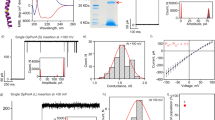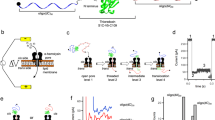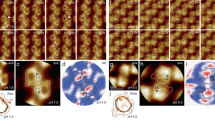Abstract
Despite its fundamental and critical importance in molecular biology and practical medical biotechnology, how a polypeptide interacts with a transmembrane protein pore is not yet comprehensively understood. Here, we employed single-channel electrical recordings to reveal the interactions of short polypeptides and small folded proteins with a robust β-barrel protein pore. The short polypeptides were ∼25 residues in length, resembling positively charged targeting presequences involved in protein import. The proteins were consisted of positively charged pre-cytochrome b 2 fragments (pb2) fused to the small ribonuclease barnase (∼110 residues, Ba). Single-molecule experiments exploring the interaction of a folded pb2-Ba protein with a single β-barrel pore, which contained negatively charged electrostatic traps, revealed the complexity of a network of intermolecular forces, including driving and electrostatic ones. In addition, the interaction was dependent on other factors, such as the hydrophobic content of the interacting polypeptide, the location of the electrostatic trap, the length of the pb2 presequence and temperature. This single-molecule approach together with protein design of either the interacting polypeptide or the pore lumen opens new opportunities for the exploration of the polypeptide–pore interaction at high temporal resolution. Such future studies are also expected to unravel the advantages and limitations of the nanopore technique for the detection and exploration of individual polypeptides.







Similar content being viewed by others
References
Becker L, Bannwarth M, Meisinger C, Hill K, Model K, Krimmer T, Casadio R, Truscott KN, Schulz GE, Pfanner N, Wagner R (2005) Preprotein translocase of the outer mitochondrial membrane: reconstituted Tom40 forms a characteristic TOM pore. J Mol Biol 353:1011–1020
Cheley S, Braha G, Lu XF, Conlan S, Bayley H (1999) A functional protein pore with a “retro” transmembrane domain. Protein Sci 8:1257–1267
Chen YX, Mant CT, Hodges RS (2003) Temperature selectivity effects in reversed-phase liquid chromatography due to conformation differences between helical and non-helical peptides. J Chromatogr A 1010:45–61
Contreras Martinez LM, Martinez-Veracoechea FJ, Pohkarel P, Stroock AD, Escobedo FA, DeLisa MP (2006) Protein translocation through a tunnel induces changes in folding kinetics: a lattice model study. Biotechnol Bioeng 94:105–117
Delano WL (2007) DeLano Scientific. San Carlos, CA
Fischer A, Montal M (2007) Single molecule detection of intermediates during botulinum neurotoxin translocation across membranes. Proc Natl Acad Sci USA 104:10447–10452
Gabriel K, Buchanan SK, Lithgow T (2001) The alpha and the beta: protein translocation across mitochondrial and plastid outer membranes. Trends Biochem Sci 26:36–40
Goodrich CP, Kirmizialtin S, Huyghues-Despointes BM, Zhu AP, Scholtz J.M., Makarov DE, Movileanu L (2007) Single-molecule electrophoresis of beta-hairpin peptides by electrical recordings and Langevin dynamics simulations. J Phys Chem B 111:3332–3335
Guiard B (1985) Structure, expression and regulation of a nuclear gene encoding a mitochondrial protein: the yeast L(+)-lactate cytochrome c oxidoreductase (cytochrome b2). EMBO J 4:3265–3272
Halverson KM, Panchal RG, Nguyen TL, Gussio R, Little SF, Misakian M, Bavari S, Kasianowicz JJ (2005) Anthrax biosensor, protective antigen ion channel asymmetric blockade. J Biol Chem 280:34056–34062
Hanggi P, Talkner P, Borkovec M (1990) Reaction-rate theory - 50 years after kramers. Rev Mod Phys 62:251–341
Hinnah SC, Wagner R, Sveshnikova N, Harrer R, Soll J (2002) The chloroplast protein import channel Toc75: Pore properties and interaction with transit peptides. Biophys J 83:899–911
Howorka S, Movileanu L, Braha O, Bayley H (2001) Kinetics of duplex formation for individual DNA strands within a single protein nanopore. Proc Natl Acad Sci USA 98:12996–13001
Huang S, Ratliff KS, Matouschek A (2002) Protein unfolding by the mitochondrial membrane potential. Nat Struct Biol 9:301–307
Huang L, Kirmizialtin S, Makarov DE (2005) Computer simulations of the translocation and unfolding of a protein pulled mechanically through a pore. J Chem Phys 123:124903
Jung Y, Bayley H, Movileanu L (2006) Temperature-responsive protein pores. J Am Chem Soc 128:15332–15340
Kang XF, Gu LQ, Cheley S, Bayley H (2005) Single protein pores containing molecular adapters at high temperatures. Angew Chem Int Ed Engl 44:1495–1499
Karginov VA, Nestorovich EM, Moayeri M, Leppla SH, Bezrukov SM (2005) Blocking anthrax lethal toxin at the protective antigen channel by using structure-inspired drug design. Proc Natl Acad Sci USA 102:15075–15080
Kasianowicz JJ, Brandin E, Branton D, Deamer DW (1996) Characterization of individual polynucleotide molecules using a membrane channel. Proc Natl Acad Sci USA 93:13770–13773
Kirmizialtin S, Ganesan V, Makarov DE (2004) Translocation of a beta-hairpin-forming peptide through a cylindrical tunnel. J Chem Phys 121:10268–10277
Kirmizialtin S, Huang L, Makarov DE (2006) Computer simulations of protein translocation. Phys Stat Sol (b) 243:2038–2047
Koriazova LK, Montal M (2003) Translocation of botulinum neurotoxin light chain protease through the heavy chain channel. Nat Struct Biol 10:13–18
Krantz BA, Melnyk RA, Zhang S, Juris SJ, Lacy DB, Wu Z, Finkelstein A, Collier RJ (2005) A phenylalanine clamp catalyzes protein translocation through the anthrax toxin pore. Science 309:777–781
Krantz BA, Finkelstein A, Collier RJ (2006) Protein translocation through the anthrax toxin transmembrane pore is driven by a proton gradient. J Mol Biol 355:968–979
Krasilnikov OV, Bezrukov SM (2004) Polymer partitioning from nonideal solutions into protein voids. Macromolecules 37:2650–2657
Krasilnikov OV, Merzlyak PG, Yuldasheva LN, Rodrigues CG, Bhakdi S, Valeva A (2000) Electrophysiological evidence for heptameric stoichiometry of ion channels formed by Staphylococcus aureus alpha-toxin in planar lipid bilayers. Mol Microbiol 37:1372–1378
Krasilnikov OV, Rodrigues CG, Bezrukov SM (2006) Single polymer molecules in a protein nanopore in the limit of a strong polymer-pore attraction. Phys Rev Lett 97:018301
Krause E, Bienert M, Schmieder P, Wenschuh H (2000) The helix-destabilizing propensity scale of D-amino acids: the influence of side chain steric effects. J Am Chem Soc 122:4865–4870
Kyte J, Doolittle RF (1982) A simple method for displaying the hydropathic character of a protein. J Mol Biol 157:105–132
Makarov DE (2007) Unraveling individual molecules by mechanical forces: theory meets experiment. Biophys J 92:4135–4136
Matouschek A, Glick BS (2001) Barreling through the outer membrane. Nat Struct Biol 8:284–286
Matouschek A, Azem A, Ratliff K, Glick BS, Schmid K, Schatz G (1997) Active unfolding of precursor proteins during mitochondrial protein import. EMBO J 16:6727–6736
Mauguen Y, Hartley RW, Dodson EJ, Dodson GG, Bricogne G, Chothia C, Jack A (1982) Molecular structure of a new family of ribonucleases. Nature 297:162–164
McManus OB, Magleby KL (1988) Kinetic states and modes of single large-conductance calcium-activated potassium channels in cultured rat skeletal-muscle. J Physiol (Lond) 402:79–120
Melnyk RA, Collier RJ (2006) A loop network within the anthrax toxin pore positions the phenylalanine clamp in an active conformation. Proc Natl Acad Sci USA 103:9802–9807
Menestrina G (1986) Ionic channels formed by Staphylococcus-Aureus Alpha-Toxin—voltage-dependent inhibition by divalent and trivalent cations. J Membr Biol 90:177–190
Misakian M, Kasianowicz JJ (2003) Electrostatic influence on ion transport through the alphaHL channel. J Membr Biol 195:137–146
Mitchell JBO, Smith J (2003) D-amino acid residues in peptides and proteins. Proteins 50:563–571
Movileanu L, Bayley H (2001) Partitioning of a polymer into a nanoscopic protein pore obeys a simple scaling law. Proc Natl Acad Sci USA 98:10137–10141
Movileanu L, Howorka S, Braha O, Bayley H (2000) Detecting protein analytes that modulate transmembrane movement of a polymer chain within a single protein pore. Nat Biotechnol 18:1091–1095
Movileanu L, Cheley S, Howorka S, Braha O, Bayley H (2001) Location of a constriction in the lumen of a transmembrane pore by targeted covalent attachment of polymer molecules. J Gen Physiol 117:239–251
Movileanu L, Cheley S, Bayley H (2003) Partitioning of individual flexible polymers into a nanoscopic protein pore. Biophys J 85:897–910
Movileanu L, Schmittschmitt JP, Scholtz JM, Bayley H (2005) Interactions of the peptides with a protein pore. Biophys J 89:1030–1045
Muro C, Grigoriev SM, Pietkiewicz D, Kinnally KW, Campo ML (2003) Comparison of the TIM and TOM channel activities of the mitochondrial protein import complexes. Biophys J 84:2981–2989
Oukhaled G, Mathe J, Biance A-L, Bacri L, Betton J-M, Lairez D, Pelta J, Auvray L (2007) Unfolding of proteins and long transient conformations detected by single nanopore recording. Phys Rev Lett 98:158101
Paddon CJ, Hartley RW (1987) Expression of Bacillus amyloliquefaciens extracellular ribonuclease (barnase) in Escherichia coli following an inactivating mutation. Gene 53:11–19
Pastoriza-Gallego M, Oukhaled G, Mathe J, Thiebot B, Betton JM, Auvray L, Pelta J (2007) Urea denaturation of alpha-hemolysin pore inserted in planar lipid bilayer detected by single nanopore recording: loss of structural asymmetry. FEBS Lett 581:3371–3376
Roise D, Theiler F, Horvath SJ, Tomich JM, Richards JH, Allison DS, Schatz G (1988) Amphiphilicity is essential for mitochondrial presequence function. EMBO J 7:649–653
Sackmann B, Neher E (1995) Single-channel recording. Kluwer, New York
Schwartz MP, Matouschek A (1999) The dimensions of the protein import channels in the outer and inner mitochondrial membranes. Proc Natl Acad Sci USA 96:13086–13090
Simon SM, Peskin CS, Oster GF (1992) What drives the translocation of proteins. Proc Natl Acad Sci USA 89:3770–3774
Song LZ, Hobaugh MR, Shustak C, Cheley S, Bayley H, Gouaux JE (1996) Structure of staphylococcal alpha-hemolysin, a heptameric transmembrane pore. Science 274:1859–1866
Tian P, Andricioaei I (2005) Repetitive pulling catalyzes co-translocational unfolding of barnase during import through a mitochondrial pore. J Mol Biol 350:1017–1034
Wells DB, Abramkina V, Aksimentiev A (2007) Exploring transmembrane transport through alpha-hemolysin with grid-steered molecular dynamics. J Chem Phys 127:125101
West DK, Brockwell DJ, Paci E (2006) Prediction of the translocation kinetics of a protein from its mechanical properties. Biophys J 91:L51–L53
Wickner W, Schekman R (2005) Protein translocation across biological membranes. Science 310:1452–1456
Wolfe AJ, Mohammad MM, Cheley S, Bayley H, Movileanu L (2007) Catalyzing the translocation of polypeptides through attractive interactions. J Am Chem Soc 129:14034–14041
Zakharov SD, Erukova VY, Rokitskaya TI, Zhalnina MV, Sharma O, Loll PJ, Zgurskaya HI, Antonenko YN, Cramer WA (2004) Colicin occlusion of OmpF and TolC channels: outer membrane translocons for colicin import. Biophys J 87:3901–3911
Acknowledgments
The authors thank Andreas Matouschek for providing the pb2-Ba proteins, Steve Cheley for supplying the αHL-RL3 plasmids, Aaron J. Wolfe for his help during the preliminary stage of this work, and Hagan Bayley, Dmitrii Makarov, and Serdal Kirmizialtin for stimulating discussions. This work was supported by Syracuse University start-up funds, and the US National Science Foundation DMR-706517 (to L.M.).
Author information
Authors and Affiliations
Corresponding author
Rights and permissions
About this article
Cite this article
Mohammad, M.M., Movileanu, L. Excursion of a single polypeptide into a protein pore: simple physics, but complicated biology . Eur Biophys J 37, 913–925 (2008). https://doi.org/10.1007/s00249-008-0309-9
Received:
Revised:
Accepted:
Published:
Issue Date:
DOI: https://doi.org/10.1007/s00249-008-0309-9




